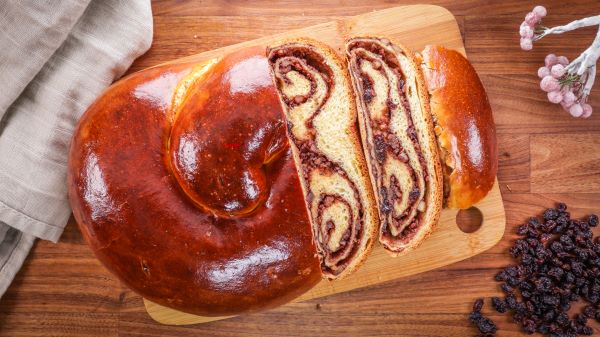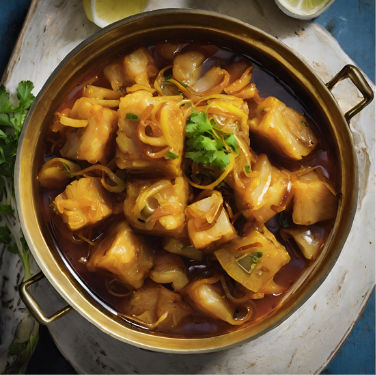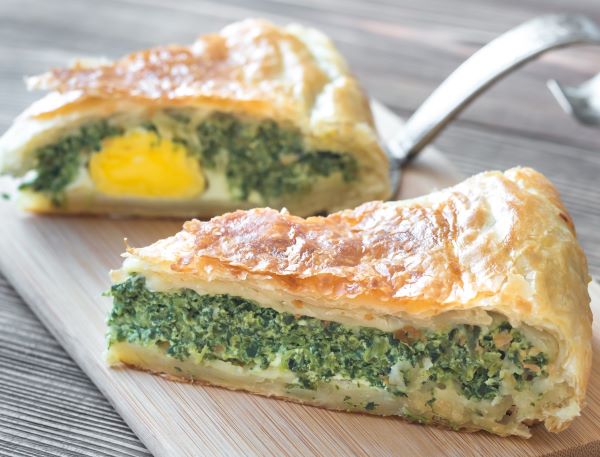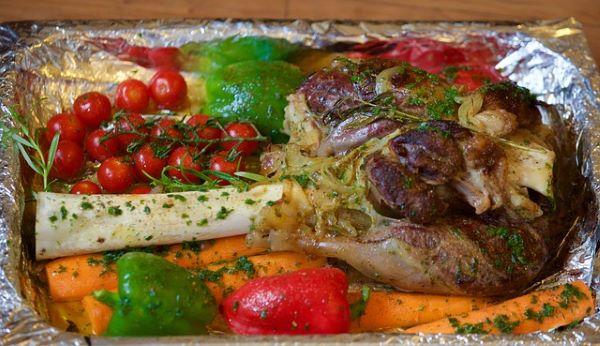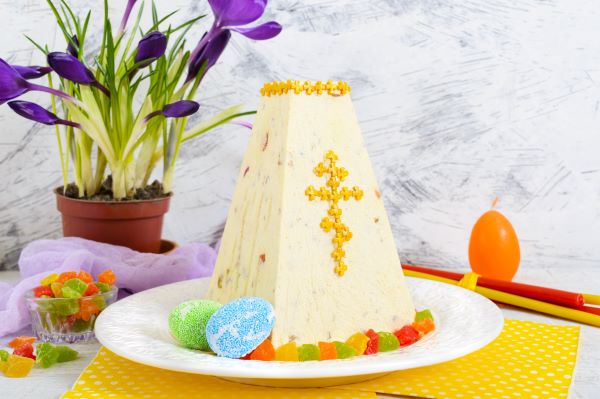As Easter approaches, kitchens around the globe come alive with the aromas of cherished family recipes and culinary traditions passed down through generations.
From savoury mains to decadent desserts, Easter celebrations are rich with diverse culinary delights that reflect the unique flavours and customs of each culture.
Embark on a gastronomic journey this Easter as we explore twelve mouthwatering dishes, each representing the culinary heritage and festive spirit of different corners of the world.
Delicious International Easter Delicacies
1. The United Kingdom—Hot Cross Buns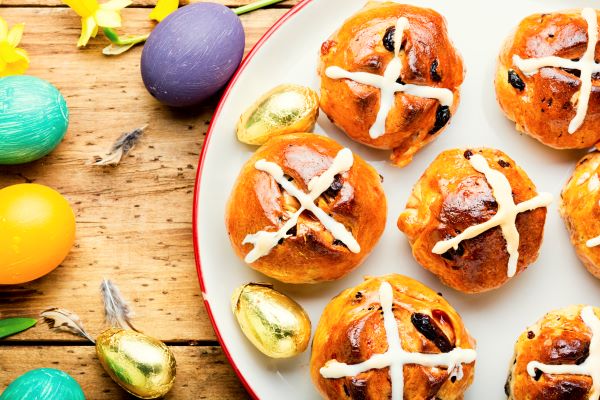
In the UK, hot cross buns are a quintessential Easter treat enjoyed during the Easter season, particularly on Good Friday.
These spiced sweet buns are made from a yeasted dough enriched with ingredients such as currants or raisins, citrus zest, and warm spices like cinnamon, nutmeg, and allspice. The spices incorporated into the dish are said to represent the spices that were used to embalm Christ after his death.
Traditionally, they are marked with a cross on top, either made from a simple flour and water paste or with icing, which symbolises the crucifixion of Jesus Christ. The buns are typically soft, fluffy, and slightly sweet, often enjoyed toasted and buttered.
Hot cross buns have been associated with Easter in the UK for centuries, with their origins dating back to ancient pagan and Christian traditions.
The buns were traditionally baked and consumed as part of the Easter celebrations, symbolising the end of Lenten fasting and the arrival of spring.
Traditionally eaten on Good Friday, they are a seasonal specialty typically available only during the weeks leading up to Easter Sunday, which adds to their allure and symbolism as an Easter treat.
Today, hot cross buns remain a beloved Easter tradition in the UK, enjoyed by people of all ages as a delicious and symbolic treat that heralds the arrival of Easter.
Check out the recipe here: Traditional Hot Cross Buns
2. Italy—Gubana
Gubana is a traditional Italian pastry hailing from the Friuli Venezia Giulia region in northeastern Italy.
It is a sweet, yeasted bread roll filled with a rich mixture of dried fruits, nuts, spices, and sometimes chocolate or liqueur.
The filling often includes ingredients like walnuts, raisins, almonds, pine nuts, candied orange peel, and cinnamon, creating a delightful blend of flavours and textures. Once assembled, the pastry is typically rolled into a spiral shape, baked until golden brown, and then brushed with syrup or honey for added sweetness and shine.
Traditionally, Gubana is prepared during Easter time as a special treat to celebrate the end of Lent and the arrival of spring. Its rich and indulgent ingredients make it a fitting dessert for festive occasions, symbolising abundance, renewal, and the joy of Easter.
Today, Gubana remains a beloved Easter tradition in Friuli Venezia Giulia and beyond, enjoyed by families and communities as a symbol of faith, togetherness, and delicious indulgence.
Check out the recipe here: Gubana
3. South Africa—Cape Malay Pickled Fish
Cape Malay Pickled Fish is a traditional South African dish with roots in the Cape Malay community, known for its vibrant flavours and cultural significance.
It consists of firm white fish, such as snoek or yellowtail, that is marinated in a blend of aromatic spices, including curry powder, turmeric, ginger, and garlic.
Oftentimes served with hot cross buns, the marinated fish is then fried until golden brown and layered with a tangy and sweet pickling sauce made from vinegar, sugar, onions, and various spices like bay leaves and peppercorns. After marinating for a few days, the flavours meld together, resulting in the deliciously tangy and aromatic dish of Cape Malay pickled fish.
The association of Cape Malay Pickled Fish with Easter in South Africa stems from historical and cultural traditions.
In the Cape Malay community, pickled fish has been a staple dish during Easter for generations, dating back to the arrival of slavery from the Dutch East India Company that caused Cape Malay to become a melting pot of cultures and cuisines.
During Lent, Christians traditionally abstained from eating meat, leading to an abundance of fish-based dishes during this period. Pickled fish became a popular choice due to its ability to preserve fish for longer periods, making it ideal for the Lenten season.
Today, Cape Malay Pickled Fish continues to be enjoyed as a beloved Easter dish in South Africa, cherished for its rich flavours and cultural heritage.
Check out the recipe here: Cape Malay Pickled Fish
4. Argentina—Pascualina
In Argentina, Pascualina is a cherished Easter dish that holds both culinary and cultural significance.
Originally brought over by Italian immigrants from the Liguria region, this savoury pie has since become a staple Easter dish in Argentina, featuring a flaky pastry crust filled with a mixture of spinach, ricotta or other cheeses, onions, and sometimes hard-boiled eggs.
The name "Pascualina" is derived from "Pascua," the Spanish word for Easter, reflecting its association with the holiday.
Pascualina's status as an Easter dish in Argentina can be attributed to several factors.
Firstly, the ingredients commonly used in Pascualina, such as cheese and eggs are symbolic of the Christian religion.
Traditionally, in the dish, three cheeses would be used to represent the trinity, four eggs would be used to represent the four evangelists, and the puff pastry would be made from 33 layers (the age of Jesus when he died and rose again).
Moreover, the dish's popularity during Easter is also influenced by cultural practices and family traditions, with many households over several generations preparing and enjoying Pascualina as part of their Easter feasts.
Its delicious flavours, hearty ingredients, and symbolic significance make Pascualina a beloved culinary tradition during the Easter season in Argentina.
Check out the recipe here: Torta Pascualina
5. The United States— Coconut “Easter Bunny Cake”
Coconut Easter Bunny cakes are adorable Easter-themed desserts that are popular in many households during the Easter season.
These cakes are shaped like bunnies, adorned with coconut flakes to resemble fur, and decorated with candies—such as jellybeans—or icing to create features like eyes, noses, and whiskers.
The cakes are often moist and flavourful, with a coconut-infused batter and sometimes filled or topped with coconut cream frosting for an extra burst of flavour.
The association of coconut bunny cakes with Easter stems from both cultural and seasonal factors.
Bunnies are a common symbol of Easter in the United States, particularly because of the tradition of the Easter Bunny—A folklore figure symbolising Easter in the form of a rabbit who delivers Easter eggs and candies to children while they are sleeping the night before Easter Sunday.
Incorporating bunny-shaped cakes into Easter celebrations adds a festive and whimsical touch to the holiday festivities, especially for children.
For many families all over the United States, coconut bunny cakes have become a beloved Easter tradition, offering a delightful and delicious way to celebrate the season.
Check out the recipe here: Coconut Easter Bunny Cake
6. Spain—Hornazo
Hornazo is a traditional Spanish savoury pastry that is closely associated with Easter, particularly in the regions of Salamanca and Castile and León.
It's a type of stuffed bread or pie typically filled with a mixture of meats, such as cured ham, chorizo, and pork loin, along with hard-boiled eggs. The dough is usually made from flour, water, yeast, and olive oil, resulting in a crusty exterior with a soft interior.
Hornazo is typically eaten on "Lunes de Aguas," a regional celebration in the city of Salamanca, Spain, occurring on the Monday following Easter Monday. During this event, locals traditionally enjoy picnics by the river and consume this traditional dish.
The origins of hornazo can be traced back to medieval times when it was customary for families to prepare large meals on Easter Sunday to celebrate the end of Lent.
Hornazo was often included in these feasts as a hearty and indulgent dish to mark the occasion. Its ingredients, particularly the eggs and meats, symbolise abundance and fertility, reflecting the renewal of life associated with Easter.
In addition to its culinary significance, hornazo also has cultural and religious importance. In some regions, it's traditional for families to take their hornazo to church on Easter Sunday to be blessed by the priest before enjoying it as part of a festive meal. This custom further underscores the connection between hornazo and Easter celebrations in Spain.
Check out the recipe here: Hornazo de Salamanca
7. Poland—White Borscht and Żurek
White Borscht and Żurek are both traditional Polish soups that hold significant cultural and culinary importance, especially during Easter celebrations.
White Borscht, known as "Biały Barszcz" in Polish, is a creamy and tangy soup made from wheat flour, along with ingredients such as white sausage (biala kielbasa), potatoes, sour cream, and sometimes hard-boiled eggs. The soup is typically seasoned with marjoram, garlic, and sometimes horseradish or vinegar, giving it a distinctive flavour profile.
White Borscht is often served as a first course during Easter brunch or dinner, symbolising rebirth and the freshness of spring with its light and refreshing taste.
Żurek, also known as "Żur" or "Żurek wielkanocny," is another traditional Polish Easter soup made from fermented rye flour or bread starter (zakwas), giving it a slightly sour taste. It's often cooked with smoked sausage, bacon, potatoes, parsnips, celery, garlic, carrots, and sometimes hard-boiled eggs or mushrooms. The soup is typically flavoured with bay leaves, allspice, and marjoram, resulting in a rich and hearty broth.
Żurek is considered an Easter dish in Poland due to its association with the Easter Vigil, a solemn and significant liturgical service held on Holy Saturday evening. It's customary for Polish families to break their Lenten fast with a bowl of Żurek after attending the Easter Vigil Mass, making it an integral part of the Easter festivities and symbolising the end of the Lenten season.
Check out the recipe here: White Borscht and Żurek
8. Germany—Kerbelsuppe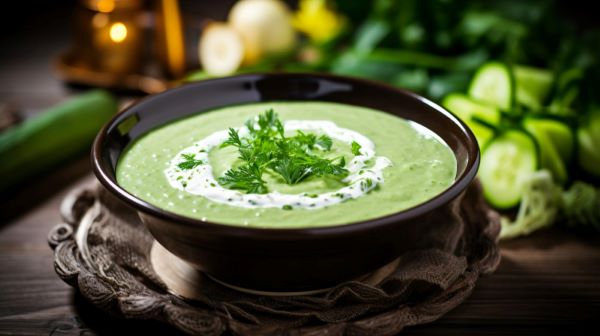
Kerbelsuppe, also known as Kerbel soup, is a traditional German soup made with the herb chervil (kerbel in German).
The soup typically includes ingredients like broth (often chicken or vegetable), chervil leaves, onions, potatoes, cream, and sometimes other herbs such as parsley or dill.
It is considered a light and fragrant soup that is often served as a starter or small meal—especially during the spring when chervil is in season.
In Germany, the Thursday before Good Friday is known as Gründonnerstag, or Green Thursday.
Although this holiday originally commemorated Christ’s Last Supper, it has since evolved into a celebration marking the start of spring in which it is custom to eat green vegetables, salads, and soups.
This is why this fresh, green soup is often associated with Easter.
Check out the recipe here: German Potato and Chervil Soup
9. Tsoureki—Greece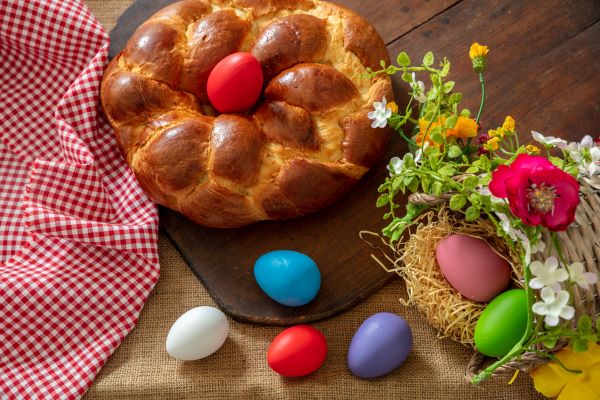
Tsoureki is a traditional Greek Easter bread that holds deep cultural and religious significance in Greek Orthodox tradition.
Its distinctive braided shape symbolises the Holy Trinity—Father, Son, and Holy Spirit—while the red-dyed eggs adorning the bread represent the blood of Christ and the promise of new life through his resurrection.
This sweet, aromatic bread is enriched with ingredients like butter, eggs, and milk, flavoured with spices such as mahlab and mastiha, and often infused with citrus zest.
Tsoureki's association with Easter stems from its role as a celebratory food marking the end of the Lenten fast. Throughout Lent, Orthodox Christians abstain from certain foods, making Easter a time for feasting and rejoicing. Tsoureki's rich, sweet flavour makes it a perfect indulgence for this occasion, symbolising the joy and abundance of the resurrection.
The process of making Tsoureki is a cherished tradition, often involving multiple generations of family members coming together to knead, braid, and bake the bread, reinforcing familial bonds and passing down cultural heritage.
Check out the recipe here: Traditional Tsoureki Recipe
10. France—Leg of Lamb
A French leg of lamb, or "le gigot d'agneau," is a classic Easter dish in French cuisine.
It typically consists of a whole leg of lamb, often with the bone left in for added flavour, seasoned with garlic, rosemary, thyme, and other aromatic herbs.
The lamb is usually roasted until tender and succulent, resulting in a flavourful and impressive centrepiece for the Easter table.
In some variations, the lamb may be marinated beforehand or served with a sauce made from pan drippings, wine, or herbs to enhance its flavour further.
The tradition of serving leg of lamb for Easter in France has both culinary and cultural significance. Lamb is a symbolic meat in Christianity, representing sacrifice and redemption, and it has been associated with Easter since ancient times. In the Christian tradition, Jesus is often referred to as the "Lamb of God," and lamb was commonly eaten during Easter feasts as a way to commemorate the sacrifice of Jesus on the cross.
In France, the tradition of serving leg of lamb for Easter has endured over the centuries, and it remains a beloved and cherished dish that brings families together to celebrate the joyous occasion of Easter.
Check out the recipe here: Le Gigot D'Agneau Pascal
11. Ethiopia—Difo Dabo
Difo Dabo, also known as Ethiopian Easter bread, holds a special place in Ethiopian Orthodox Christian culture and cuisine, particularly during the Easter season.
"Difo Dabo" is an Amharic term that translates to "wheat bread.”
This sweet and spiced bread is typically made with ingredients such as flour, yeast, sugar, and often flavoured with spices like cardamom and nutmeg.
However, it is important to note that there are many variations of this bread. Typically, the version of difo dabo associated with Easter, or Fasika, is called “yemarina yewotet dabo.” This version is comprised of a round wheat loaf of bread enriched with milk and honey.
Its name and ingredients of “milk and honey” are a reference to the Biblical promised land of Canaan, a land that was said to be flowing with milk and honey.
Traditionally, difo dabo is wrapped in banana leaves and baked in a round clay pot over the embers of a fire pit.
As a central element of the Easter feast, its sweet aroma and intricate decoration evoke feelings of joy and abundance, reflecting the spiritual significance of the resurrection and the promise of new life.
Check out the recipe here: Dabo Ethiopian Milk and Honey Bread
12. Russia—Paskha
Paskha is a traditional Russian Easter dessert that holds profound cultural and religious significance within the Orthodox Christian tradition.
This rich and creamy delicacy is prepared with a base of farmer's cheese (tvorog), mixed with eggs, sugar, butter, and sometimes sour cream.
Often adorned with almonds, candied fruits, and raisins, it's shaped into a pyramid or cylinder and intricately decorated with religious symbols like the letters "XB" (signifying "Christ is risen" in Russian) and crosses.
It is traditionally served alongside and spread upon a rich Russian bread known as kulich.
Paskha's association with Easter is deeply rooted in its symbolism and tradition. As the most important religious holiday in the Orthodox Christian calendar, Easter celebrates the resurrection of Jesus Christ.
Paskha serves as a tangible expression of this joyous occasion, with its rich ingredients representing the abundance of new life and its intricate decorations reflecting the spiritual significance of the resurrection.
For this reason, it is often made during the holy week and then brought to church on Great Saturday to be blessed after the vigil.
Moreover, the communal aspect of preparing and sharing Paskha with loved ones reinforces bonds of faith and family, making it an integral part of Russian Easter celebrations for generations.
Check out the recipe here: Paskha Russian Cheesecake
Let's Get Cooking!
With these tantalising recipes in hand, may your Easter table be filled not only with delicious food but also with the warmth of shared traditions and the joy of culinary exploration.
As we savour the flavours of Easter from around the world, let us embrace the cultural richness and culinary diversity that make this holiday truly special.
What are you waiting for? It’s time to dig into these delicious Easter delicacies.
Bon Appétit.

